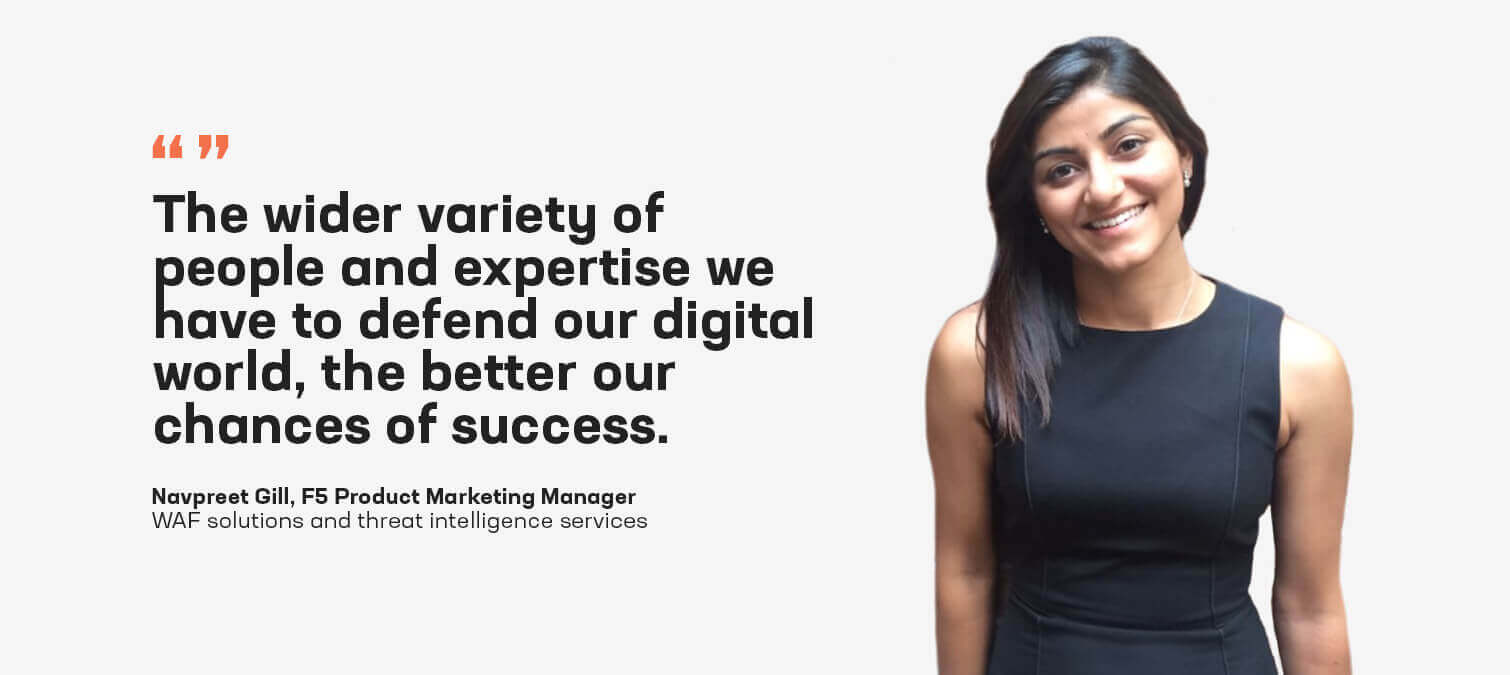Un viaje hacia la equidad de género: Preguntas y respuestas con Navpreet Gill sobre el empoderamiento de las mujeres en ciberseguridad
El Día Internacional de la Mujer (DIM) es el 8 de marzo. Si bien es un día mundial dedicado a celebrar los numerosos logros de las mujeres, también es un día para acelerar la equidad de género. El tema de este año, #EmbraceEquity, es un recordatorio aleccionador de que el panorama de la ciberseguridad sigue estando muy sesgado : el 75 % de los trabajadores de ciberseguridad son hombres.
Se están realizando avances para mejorar la situación actual. Pero las proyecciones muestran que podría tomar más de 130 años cerrar la brecha de género si el mundo mantiene el ritmo actual.
Para ayudar a inspirar más cambios ahora y ofrecer perspectivas únicas sobre la importancia de cerrar la brecha de género, me senté con Navpreet Gill para iniciar una serie de blogs con personas de identidades de género subrepresentadas en la ciberseguridad en F5 y obtuve su opinión sobre el valor de continuar empoderando a las mujeres para que sean parte de la ciberseguridad, no solo en el Día Internacional de la Mujer, sino todos los días.
Navpreet ha trabajado con F5 durante más de tres años. Su función se centra en el marketing de productos para soluciones de firewall de aplicación web (WAF), incluido F5 BIG-IP Advanced WAF y servicios de inteligencia de amenazas. Anteriormente, Navpreet ayudó a impulsar el marketing de productos y el desarrollo comercial para empresas emergentes de seguridad en Silicon Valley. Su experiencia con empresas emergentes de seguridad inspiró su pasión por posicionar y comunicar productos y soluciones que aborden mejor los casos de uso de los clientes e impulsen el negocio. En su tiempo libre, a Navpreet le gusta escalar, esquiar y hacer senderismo con su perro, Henry.
Raquel: Tuve una trayectoria profesional no lineal antes de aterrizar en la ciberseguridad. ¿Cómo entraste en la industria?
Navpreet: Poco después de mi estancia en UCLA, recibí una carta de mi proveedor de atención médica notificándome que yo era uno de los pocos millones de personas afectadas por una violación reciente. Me acababa de mudar de Los Ángeles a Silicon Valley y estaba buscando trabajo, así que comencé a establecer contactos en el ámbito tecnológico. Mis mentores me impulsaron a seguir adelante y me animaron a buscar roles en ciberseguridad.
En esencia, la ciberseguridad consiste en proteger a las personas de ser víctimas, y en mi carrera he disfrutado estar del lado de la defensa, protegiendo a las personas de daños, persiguiendo a los malos actores y aprendiendo continuamente. Me encanta ver el impacto de mi trabajo. El entorno de ritmo rápido me mantiene concentrado y hace que mi carrera sea agradable.
Raquel: Muchos han surgido como defensores de la diversidad y la inclusión en la tecnología, pero la ciberseguridad sigue teniendo dificultades para cerrar la brecha de género. ¿Qué oportunidades existen para superar la brecha?
Navpreet: Tener más mujeres en el lugar de trabajo es bueno para los negocios, ya que aporta diversidad de perspectivas, liderazgo y experiencia. Si bien esto puede aplicarse a cualquier puesto en una empresa, es crucial en el ámbito de la ciberseguridad. Necesitamos personas con diferentes antecedentes porque estamos buscando adversarios cibernéticos y piratas informáticos que también tienen diversos antecedentes y experiencias. Cuanto mayor sea la variedad de personas y conocimientos que tengamos para defender nuestro mundo digital, mayores serán nuestras posibilidades de éxito.
Raquel: No podría estar más de acuerdo. Hace unos años, la Universidad de Maryland informó que ocurre un ciberataque cada 39 segundos, y cada vez es más fácil con tácticas en evolución como el ransomware como servicio . ¿Cómo podemos orientar a más mujeres hacia la ciberseguridad? ¿Qué necesita cambiar?
Navpreet: Creo que es un problema de percepción: en casa y en la escuela, las niñas suelen ser encaminadas a asumir roles más tradicionales. La falta de modelos a seguir también tiene una influencia significativa, entre otros factores como el dominio masculino y la presión de grupo, que introduce la idea de STEM como algo geek.
Podemos cambiar la narrativa con un cambio cultural. Los docentes y orientadores deberían alentar a las jóvenes a buscar carreras STEM y destacar modelos a seguir dentro del sistema educativo. En el lugar de trabajo, los empleadores deben realizar esfuerzos programáticos para contratar y retener mujeres en TI, brindando equidad salarial y caminos iguales para la promoción, junto con un entorno de trabajo inclusivo en cuanto a género.

Raquel: Me entusiasma ver acciones que desafíen el status quo. Y me energiza todo lo que está pasando hoy en día en materia de ciberseguridad. ¿Qué tipo de tendencias actuales te hacen sentarte un poco más erguido?
Navpreet: Lo que más me entusiasma es la Inteligencia Artificial (IA) en la ciberseguridad.
Los ciberataques no van a desaparecer: seguirán aumentando en frecuencia y sofisticación. Se ha vuelto bastante complicado para los expertos en ciberseguridad reaccionar ante todos ellos. Los hackers y ciberdelincuentes han estado utilizando la IA. En muchos casos, los algoritmos de IA se emplean para detectar sistemas de seguridad vulnerables que contienen información valiosa. La IA también puede crear varios correos electrónicos de phishing personalizados para engañar a los destinatarios y hacer que proporcionen información confidencial. Los ataques impulsados por IA también pueden ser más personalizados y más efectivos; su creciente capacidad para comprender el contexto significa que serán aún más difíciles de detectar.
Raquel: Como usar ChatGPT para ataques maliciosos . No todo está perdido para la IA bien intencionada, ¿verdad?
Navpreet: Totalmente. Los algoritmos de aprendizaje automático pueden examinar con mayor eficacia la gran cantidad de datos que circulan por las redes en tiempo real y aprender a reconocer patrones que indican una amenaza. La inversión en nuevas tecnologías desempeñará un papel fundamental en la realidad emergente y el ecosistema en evolución. Es crucial incorporar tecnología al ecosistema para combatir el uso malicioso de la IA con la propia IA.
Por ejemplo, el análisis del comportamiento es un requisito para detectar ataques combinados. Muchos ataques de denegación de servicio distribuido (DDoS) de capa 7 son sigilosos y pueden pasar desapercibidos. BIG-IP Advanced WAF utiliza aprendizaje automático y monitoreo de datos para analizar el comportamiento del tráfico y defenderse automáticamente contra ataques DoS y DDoS.
La IA en ciberseguridad está evolucionando exponencialmente y estoy entusiasmado por ver hacia dónde va.
Otras preguntas y respuestas de esta serie de blogs

